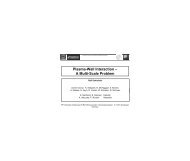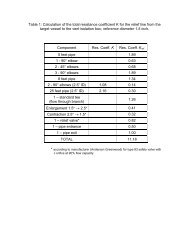The Nu-SNS proposal - ORNL Physics Division - Oak Ridge ...
The Nu-SNS proposal - ORNL Physics Division - Oak Ridge ...
The Nu-SNS proposal - ORNL Physics Division - Oak Ridge ...
You also want an ePaper? Increase the reach of your titles
YUMPU automatically turns print PDFs into web optimized ePapers that Google loves.
neutrino-nucleus interactions on nearby heavy stable nuclei would be invaluable as a gauge<br />
of the accuracy of nuclear structure and reaction predictions.<br />
3.4 Supernova Neutrino Astronomy<br />
Observations of supernova neutrino luminosities are only as accurate as knowledge of neutrino<br />
interaction rates.<br />
<strong>The</strong> twenty neutrino events detected by IMB and Kamiokande from SN1987A confirmed a<br />
central tenant of supernova theory—that core collapse supernovae mark the formation of a protoneutron<br />
star and release of the liberated binding energy in the form of neutrinos—and signaled<br />
the birth of extra-Solar-System neutrino astronomy. For a Galactic supernova, thousands of<br />
events will be seen by Super-Kamiokande [73], SNO [74], and KamLAND, which for the first<br />
time will give us detailed neutrino “light curves” and provide volumes of information about the<br />
deepest regions in the explosion. In turn, these light curves can be used to test and improve<br />
supernova models, thereby improving predictions about the explosion and resultant<br />
nucleosynthesis as well as the behavior of matter at super-nuclear densities. Moreover, from<br />
these detailed neutrino light curves and an understanding of the effects of neutrino oscillations,<br />
interesting insight could be gained about the density structure of the supernova progenitor. To<br />
achieve this will require an accurate normalization of the neutrino flux in a supernova neutrino<br />
detector and knowledge of the cross sections and by-products of neutrino interactions in the<br />
detector material. For a galactic supernova, variants of the Baade-Wesselink method will likely<br />
provide distances to the supernova with uncertainties of 10% or less [86,87], making 10% or<br />
smaller uncertainties for the neutrino-nucleus cross sections desirable. From deuterium to lead, a<br />
number of nuclei have been proposed and, in some cases, used as supernova detector materials.<br />
In all cases, accurate neutrino-nucleus cross sections are essential and currently not<br />
available. Among the neutrino-nucleus interactions most relevant for supernova neutrino<br />
detection are neutrino interactions on 2 H, C, O, Fe and Pb.<br />
While the occurrence of a Galactic supernova is a rare event, Beacom and Vagins [75] have<br />
recently suggested a modification of Super-Kamiokande that would allow detection of the<br />
diffuse supernova neutrino background, i.e., the flux from all supernovae that have occurred in<br />
the history of the universe, at the rate of 2-6 events per year. In just a few years, the yield from<br />
SN 1987A could be exceeded, allowing improved tests of numerical supernova models through<br />
the measured flux and spectral shape. In addition, this modification should also allow neutrino<br />
observations of pre-supernova massive stars within 1 kpc [76]. <strong>The</strong>se possibilities open the<br />
opportunity to expand our knowledge of supernovae (and their progenitors) on an ongoing basis<br />
while we await a nearby event.<br />
3.4.1 Oxygen<br />
In water Cherenkov detectors like the Sudbury Neutrino Observatory (SNO) and Super-<br />
Kamiokande, the charged-current reaction 16 O(ν e ,e - ) 16 F is the principal channel for electron<br />
neutrino interactions for thermal sources in the range T ν ≥ 4-5 MeV. Its rate exceeds that of<br />
neutrino-electron scattering by an order of magnitude for T ν ≥ 7-9 MeV [77]. Moreover, the<br />
electron angular distribution is strongly correlated with the electron neutrino energy [78],<br />
providing a way to measure the incident neutrino energy.<br />
ν-<strong>SNS</strong> Proposal 30 8/4/2005



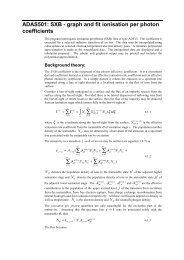
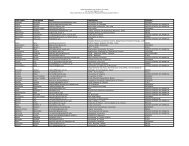
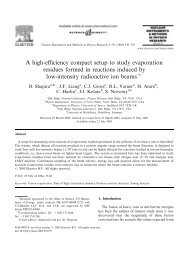
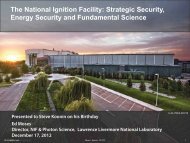

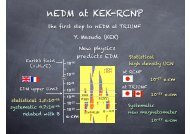
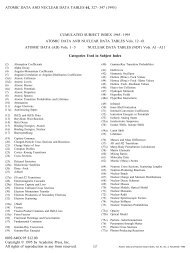


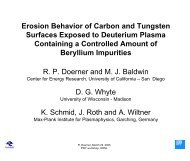
![Mixed-mode Calculations within the Nuclear Shell Model [pdf]](https://img.yumpu.com/28265410/1/190x146/mixed-mode-calculations-within-the-nuclear-shell-model-pdf.jpg?quality=85)
